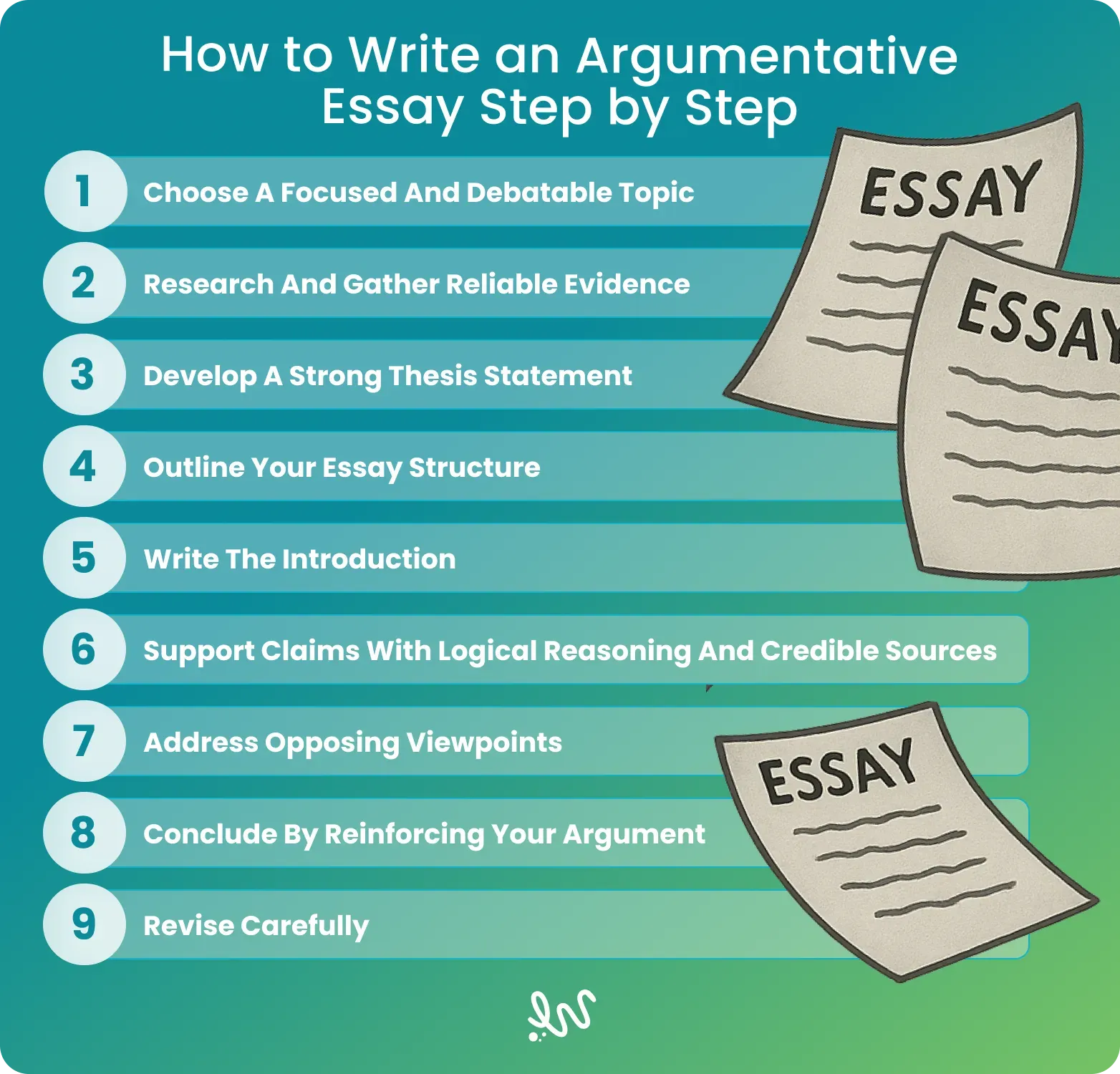An argumentative essay is a piece of writing that takes a stand on an issue and supports it with evidence. Such papers test how well your viewpoint can withstand challenges. To write one, you will have to:
- Choose a focused and debatable topic
- Research and gather reliable evidence
- Develop a strong thesis statement
- Outline your essay structure
- Write the introduction
- Support claims with logical reasoning and credible sources
- Address opposing viewpoints
- Conclude by reinforcing your argument
This guide will walk you through what defines an argumentative essay and how to make the writing process more manageable. In case you still don't know how to approach writing an argumentative essay after going through this post, you can always seek the help of WriteMyEssay for professional academic support.
Struggling To Find Sources?
WriteMyEssay's professionals can help you find credible content you can use to back up your arguments.
Ask For Help
What Is an Argumentative Essay?
An argumentative essay is formal writing built around a specific claim. That claim could involve anything that's open to debate. The writer takes a stance and builds a logical case to support it with research and analysis. Argumentative essays are set apart by a commitment to structured reasoning. Simply stating a belief won't be enough unless you examine the evidence to fully engage with the argument.
Argumentative Essay Structure
The strength of any essay often lies in how well it's built. But the structure of an argumentative essay specifically might be even more important. Here's a clear argumentative essay format:
- Introduction: Open with something that instantly grabs attention. More importantly, let the reader know why this issue, and why now.
- Body Paragraphs: Each paragraph focuses on one idea and connects back to the central point. All pieces of evidence are explained and interpreted to move the argument forward.
- Counterargument and Rebuttal: Try to anticipate disagreement. A counterargument followed by a well-reasoned response shows that your position holds strong.
- Conclusion: Reinforce your main points without sounding repetitive.
Types of Arguments
There's more than one way to build an argument. The structure you choose will ultimately decide how your message lands. The three most common approaches are the Classical, Toulmin, and Rogerian.
Classical Argument Structure
People usually recognize the classical argument right away. It's direct and structured. If your aim is to persuade your reader of something, this is a solid path.
- You start by introducing the issue.
- Then you give enough background so your reader isn't lost.
- After that, you lay out your main points, each backed by evidence.
- You take time to mention opposing views and explain why they don't hold.
- Finally, you close with a conclusion that reinforces your position.
Toulmin Argument Structure
The Toulmin method is more technical but also more precise. It's useful when your argument hinges on careful reasoning and your audience might need to understand how the pieces connect. We use the Toulmin structure for topics that aren't black and white because you also explain why your specific belief is the one that makes sense.
- You begin with a clear claim.
- You back that claim with credible support.
- Then you explain why that support matters (warrant).
- If needed, you add extra layers of support (backing).
- You anticipate objections and address them.
- You add qualifiers to show where your argument might be limited.
Rogerian Argument Structure
The Rogerian approach prioritizes listening first. This method is mostly used when a writer's goal is to lower the tension instead of taking a specific side. You aim to understand opposing viewpoints and find a common ground.
- You start by introducing the issue neutrally.
- Then you describe the opposing view respectfully.
- You introduce your own perspective, supported with reasoning.
- You point out values or goals you share with the other side.
- You finish by offering a possible middle ground or solution.
How to Write a Strong Thesis for an Argumentative Essay?
Thesis statement is the backbone of your paper. It's the part that tells your reader what you believe. The rest of your essay will have nothing to hold it together unless you write a solid thesis because each of your arguments should end up connected to this very sentence. Here's how to write one that will make your writing stronger:
- Be direct about your point. Skip the soft edges and say exactly what you're arguing.
- Leave out vague openers. Phrases like "nowadays", or "it is widely known" might sound academic, but they're the exact words you should avoid in an essay.
- Make it arguable. If your statement sounds like a fact pulled from a textbook, it won't spark much interest.
- Stick to one idea. Everything else in the essay will branch out from your thesis, so you don't need to cover every angle.
How to Write an Argumentative Essay: 9 Steps for Success
An argumentative essay is built one thoughtful step at a time. You choose your topic carefully and then guide the reader through the arguments. If you're not sure where to begin, here's a simple process that will keep your focus in place.

1. Choose a Debatable Topic
An argumentative essay can't be built around something people don't argue about. You want something that your reader might actually disagree about, so you can try and make them see why your argument makes more sense.
For example, instead of writing "climate change is dangerous," try "Governments should ban single-use plastics to reduce environmental damage." That's a claim you can actually build an argument around.
2. Look for Credible Evidence
Before writing anything, dig into the issue. Familiarize yourself with the topic from all possible sides and find reliable sources that support your side. Don't ignore the ones that challenge it, either. You'll need both to build something solid. But more on that later.
Here's a quick tip: if something sounds emotional but doesn't come with proof, skip it. The ones backed by data are the ones you want to keep.
3. Write a Focused Thesis Statement
This is the one sentence that tells your reader what you're arguing. It's the center of your essay, so keep it sharp and specific. The rest of the piece will likely follow that same pattern if it feels vague.
Example:
"School uniforms should be required because they reduce distractions and help create a more focused learning environment."
4. Outline the Structure
You don't need a formal outline, but you do need to know where your essay is headed. Think about the order of your points. What needs to come first? Where will you mention the other side? How will it all come together in the end?
Structure to keep in mind:
- Intro and thesis
- Body paragraphs with support
- Acknowledgment of the other side
- A conclusion that leaves the reader thinking
5. Write the Introduction
Sometimes the hardest part is getting started. If your introduction isn't flowing, skip it and come back. When you're ready, begin with something that makes the reader care about the issue, then lead them toward your thesis without drifting.
Example hook:
"Every day, students spend more time picking outfits than preparing for class. But what if schools made that decision easier?"
6. Build Body Paragraphs
Each paragraph should move your argument forward. Besides, each one must focus on a single clear point. Support your arguments with evidence and explain why they matter. Make sure that everything you say connects back to your thesis statement.
7. Address the Other Side
You don't have to agree with opposing views, but you do need to show that you've considered them. You prove you've actually thought about the issue by pushing counterarguments back without sounding defensive.
Example:
"Some argue that uniforms limit self-expression. While that's a fair concern, studies show students often report less peer pressure and feel more comfortable in a school environment that levels the playing field."
8. Close with Purpose
The conclusion should do more than wrap things up. You should show once again why your argument holds weight. Briefly remind the reader of your key points and leave them with something to think about.
Example ending:
"Uniforms won't fix every issue in schools, but they can help create an environment where students can focus more on learning and less on fitting in."
9. Edit and Revise
Take a break once you're done writing. Then, come back to your essay with a fresh mind. Be honest with yourself about what's working and what needs tightening. And while you're at it, cut the fluff.
Tips for Writing an Argumentative Essay
The smallest decisions can decide how your essay reads. Check out the practical tips below - they're the kind of things that make your writing feel intentional and human.
- Stop softening your statements. If you believe something, say it. Words like "I think," "I believe," or "maybe" make you sound unsure.
- Use transitions to guide the reader. Use words that carry your rhythm: "Here's the thing," "Another reason this matters," or "Let's take it further." These are the useful words to use in an essay that keep the flow natural.
- Don't let quotes do the talking for you. Evidence is there to support you, not replace your reasoning. After every fact or quote, take a beat and let your own voice lead the argument.
- End paragraphs with purpose. The last line should make the point land. Wrap it up with your own words rather than quotes.
- Say what you need to, then move on. Don't stretch a point for length. Repetition waters things down.
- Sound confident, not combative. A balanced tone strengthens your argument.
Before You Close the Tab
If you've made it this far, you are probably committed to writing a solid argumentative essay. A solid paper doesn't rely on dramatic claims alone. It's built piece by piece, with the help of logic and focus.
If you're still second-guessing your structure, WriteMyEssay is a reliable place to turn. Our argumentative essay writing service will help you with all the ins and outs of persuasive writing so you can build convincing arguments from the ground up.
FAQ
How to Start an Argumentative Essay?
Start your argumentative essay with a surprising fact or a shocking statistic. Then, give some background information so they understand what's coming. End your introduction with a thesis statement.
What Is the 5 Paragraph Format for an Argumentative Essay?
The 5 paragraph format is a simple structure often used in academic settings, especially for shorter essays or timed writing tasks. Here's how it breaks down:
- Introduction – includes a hook, background, and thesis
- First body paragraph – strongest supporting point
- Second body paragraph – another key point
- Third body paragraph – counterargument and rebuttal
- Conclusion – restates the thesis and leaves the reader with a final thought
How to Do an Argumentative Essay?
First, pick a topic that allows for a real debate. Do your research after, both on your side and the other. Once you've gathered your information, write a clear thesis that shows exactly what you're arguing. From there, build out your body paragraphs. In the end, wrap it all up with a conclusion that leaves the argument feeling complete.
Sources
- Purdue University . (2020). Argumentative essays // Purdue writing lab. Purdue Writing Lab. https://owl.purdue.edu/owl/general_writing/academic_writing/essay_writing/argumentative_essays.html
- Giulianetti, L. (2019). Suggestions for Developing Argumentative Essays | Student Learning Center. Berkeley.edu. https://slc.berkeley.edu/writing-worksheets-and-other-writing-resources/suggestions-developing-argumentative-essays



